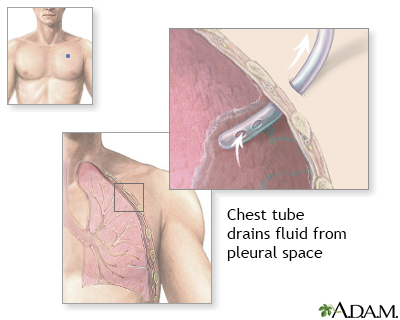Pregnancy SmartSiteTM
Chest drainage tube insertion; Insertion of tube into chest; Tube thoracostomy; Pericardial drain DefinitionA chest tube is a hollow, flexible tube placed into the chest. It acts as a drain.
DescriptionWhen your chest tube is inserted, you will lie on your side or sit partly upright, with one arm over your head.
After your chest tube insertion, you will have a chest x-ray to make sure the tube is in the right place. The chest tube most often stays in place until x-rays show that all the blood, fluid, or air has drained from your chest and your lung has fully re-expanded. The tube is easy to remove when it is no longer needed. Some people may have a chest tube inserted that is guided by x-ray, computerized tomography (CT), or ultrasound. If you have major lung or heart surgery, a chest tube will be placed while you are under general anesthesia (asleep) during your surgery. Why the Procedure Is PerformedChest tubes are used to treat conditions that cause a lung to collapse. Some of these conditions are:
RisksSome risks from the insertion procedure are:
After the ProcedureYou will most likely stay in the hospital until your chest tube is removed. In some cases, a person may go home with a chest tube. While the chest tube is in place, your health care provider will carefully check for air leaks, breathing problems, and if you need oxygen. They will also make sure the tube stays in place. Your provider will tell you whether it is OK to get up and walk around or sit in a chair. What you will need to do:
Get help right away if:
Outlook (Prognosis)The outlook depends on the reason a chest tube is inserted. Pneumothorax most often improves, but sometimes surgery is needed to correct the underlying problem. This may be performed through a scope or may require a large incision depending on your underlying condition. In cases of infection, the person improves when the infection is treated, although scarring of the lining of the lung can sometimes occur (fibrothorax). This may require surgery to correct the problem. ReferencesBoujaoude Z, Shersher D. Chest tube thoracostomy. In: Parrillo JE, Dellinger RP, eds. Critical Care Medicine: Principles of Diagnosis and Management in the Adult. 5th ed. Philadelphia, PA: Elsevier; 2019:chap 15. Margolis AM, Kirsch TD. Tube thoracostomy. In: Roberts JR, Custalow CB, Thomsen TW, eds. Roberts and Hedges' Clinical Procedures in Emergency Medicine and Acute Care. 7th ed. Philadelphia, PA: Elsevier; 2019:chap 10. Watson GA, Harbrecht BG. Chest tube placement, care, and removal. In: Vincent J-L, Moore FA, Bellomo R, Marini JJ, eds. Textbook of Critical Care. 8th ed. Philadelphia, PA: Elsevier; 2024:chap E12. | |
| |
Review Date: 4/16/2023 Reviewed By: Mary C. Mancini, MD, PhD, Cardiothoracic Surgeon, Shreveport, LA. Review provided by VeriMed Healthcare Network. Also reviewed by David C. Dugdale, MD, Medical Director, Brenda Conaway, Editorial Director, and the A.D.A.M. Editorial team. The information provided herein should not be used during any medical emergency or for the diagnosis or treatment of any medical condition. A licensed medical professional should be consulted for diagnosis and treatment of any and all medical conditions. Links to other sites are provided for information only -- they do not constitute endorsements of those other sites. No warranty of any kind, either expressed or implied, is made as to the accuracy, reliability, timeliness, or correctness of any translations made by a third-party service of the information provided herein into any other language. © 1997- A.D.A.M., a business unit of Ebix, Inc. Any duplication or distribution of the information contained herein is strictly prohibited. | |

 Chest tube inserti...
Chest tube inserti...
